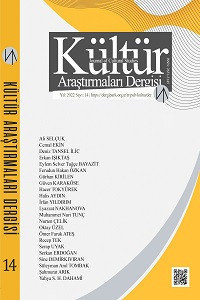Delarivier Manley’in The Royal Mischief Oyununda Erkek Bakışının Yeniden Şekillendirilmesi ve Cinsiyet Rollerinin Tersine Çevrilmesi
Restorasyon dönemi İngiltere’si İngiliz toplumunda kültür ve edebiyat açısından yeni bir dönemi işaret etmektedir. Restorasyon dönemi İngiliz tiyatrosunda kadınlar ilk defa tiyatro sahnelerinde profesyonel olarak rol almanın yanı sıra tiyatro oyunları yazarak daha önce erkelere özgü bu alanda söz sahibi olmaya başlamışlardır. Fakat kadın oyun yazarları tarafından yazılan bu oyunlar kadınlara özgü domestik konular ve kadınlara biçilen itaat, iffet ve sadakat rollerini benimsemişlerdir. Kadınların temsili bakımından ataerkil söylemleri devam ettirse de, 17. yüzyılın son döneminde Aphra Behn’i takip eden bazı kadın oyun yazarları daha çok feminist bakış açısıyla kadının ataerkil toplumdaki yeri ve konumu hususunda aykırı fikirler ve söylem içerisinde oyunlarını yazmışlardır. Yazılan bu oyunlarda daha önce erkek bakış açısıyla temsil edilen kadın bu kez bir kadın yazar gözüyle erkek egemen dünyaya başkaldıran ve onlara biçilen cinsiyet rollerini reddeden bir anlayışla sergilenmiştir. Delarivier Manley, the Royal Mischief adlı trajedisinde bu hususları yansıtarak, feminist bir bakış açısıyla oyunun başkarakterine erkek rolü yüklemiş ve daha önce erkek oyun yazarları tarafından sıklıkla sergilenen “erkeğin kadına bakışını” ve cinsiyet rollerini tersine çevirerek bu söylemleri bertaraf etmeyi amaçlamıştır. The Royal Mischief oyununda, bu bağlamda, Manley oyunun başkahramanı olan Homais’i erkek egemen dünyaya meydan okuyan güçlü bir kahraman olarak çizerek, bu anlamda ilk defa erotik arzu ve şehvetin erkeklere karşı bir kadın tarafından oluşumunu yansıtmaktadır.
Anahtar Kelimeler:
Feminizm, Delarivier Manley, Restorasyon Tiyatrosu, Kadın Bakışı, The Royal Mischief
Re-orienting The Male Gaze and Subversion of Gender Roles in Delarivier Manley’s The Royal Mischief
Women’s professional involvement in drama dates back to the restoration period in England, during which female dramatists emerged in English drama both as playwrights and actresses. The plays written by the female dramatists included mostly domestic issues, modesty, obedience, and chastity in the early restoration period, following the traits of the patriarchal authors depicting women within the limits of female virtue. Aphra Behn emerged as one of the most important and well-known dramatists of her period, who later encouraged a group of female dramatists, including Delarivier Manley, Catherine Trotter, and Mary Pix. These dramatists demonstrated female solidarity and contributed to each other’s writing, giving way to the rise of the early feminist drama in England through their plays on the question of women and their conditions in the society, challenging the patriarchal discourse. They also adopted a more radical voice sometimes by subverting the established gender roles and male gaze at times. Furthermore, these female dramatists mostly parodied and subverted traditional male libertinism as appeared in many of the restoration comedies and tragedies. Delarivier Manley, in this respect, wrote a series of plays in the direction of “proto-feminist” discourse and reversed the gender roles by giving voice to the female protagonists in her plays, especially in The Royal Mischief.
Keywords:
feminism, Delarivier Manley, Restoration Drama, Female Gaze, The Royal Mischief,
___
- Andrea, Bernadette (2007). Women and Islam in Early Modern English Literature. Cambridge: Cambridge University Press.
- Ballaster, Rosalind (Ed.). (1992). “Introduction”. New Atlantis. By Delarivier Manley. New York: New York UP, v-xxv.
- Bertucci, Christopher (2017). “Contagious Desire as Feminist Satire in Delarivier Manley’s The Royal Mischief”. Restoration Studies in English Literary Culture, 1660-1700, 41(1): 81-99.
- Hughes, Derek (2001). “General Introduction”. Eighteenth Century Women Playwrights, Vol 1. Eds. Margarete Rubik & Eva Zettelmann. London: Pickering.
- Karadaş, Fırat (2020). “Aphra Behn’in ‘Çapkın Denizci’ ve Sadık Şendil’in ‘Kanlı Nigar’ Oyunlarında Ataerkil Sistemin Cinsiyet Etiketlerini Bozan Kadın Portreleri”. Gaziantep Üniversitesi Sosyal Bilimler Dergisi, 19(2): 385-402.
- Makin, Batshua (1673). “An Essay to Revive the Ancient Education of Gentlewomen”. The Female Spectator: English Women Writers before 1800. (1977). Eds. Mary R. Mahl & Helene Koon. Bloomington and London: Indiana University Press.
- Manley, Delarivier (2001). The Royal Mischief. Eighteenth Century Women Playwrights, Vol 1. Eds. Margarete Rubik & Eva Zettelmann. London: Pickering, 51-103.
- McDowell, Paula (1998). The Women of Grub Street: Press, Politics, and Gender in the London Literary Marketplace 1678-1730. New York: Oxford UP.
- Merens, Rebecca (1996). “Unmanned with Thy Words: Regendering Tragedy in Manley and Trotter”. Broken Boundaries: Women and Feminism in Restoration Drama. Ed. Katherine M. Quinsey. Kentucky: Kentucky UP, 31-53.
- Parsons, Nicola (2003). “Secrecy and Enlightenment: Delarivier Manley’s New Atalantis”. Libertine Enlightenment: Sex Liberty and Licence in the Eighteenth Century. Eds. Peter Cryle & Lisa O’Connell. New York: Palgrave Macmillan, 145-160.
- Pearson, Jacqueline (1988). The Prostituted Muse: Images of Women and Women Dramatists, 1642-1737. New York: St. Martin’s Press.
- Quinsey, Katherine M. (1996) “Introduction”. Broken Boundaries: Women and Feminism in Restoration Drama. Ed. Katherine M. Quinsey. Kentucky: Kentucky UP.
- Rogers, Katharine M. (1994). The Meridian Anthology of Restoration and Eighteenth Century Plays by Women. New York: Meridian.
- Rubik, Margarete (1998). Early Women Dramatists 1550-1800. London: Macmillan.
- Shattock, Joanne (1993). The Oxford Guide to British Women Writers. Oxford: Oxford UP.
- Shaw, Marion (Ed.) (1998). An Introduction to Women’s Writing. London: Prentice Hall.
- Stevenson, Jane (1992). Women Writers in English Literature. Essex: Longman York Press.
- ISSN: 2651-3145
- Yayın Aralığı: Yılda 4 Sayı
- Başlangıç: 2018
- Yayıncı: Mehmet Ali YOLCU
Sayıdaki Diğer Makaleler
Sodom ve Gomore Romanının Metinlerarası Dünyası
Ahmet Telli'nin Şiirlerinde Kent Algısı
Kamusal Alanda Fatma Aliye'nin Kadın Karakterleri
Erken Cumhuriyet Dönemi Mimarisinde Ulusal Kimlik Arayışı: Ankara’daki Kamu Yapıları
Elçin Efendiyev'in Ak Deve Romanında Yapı ve İzlek
Yeni Bir Turizm Yaklaşımına Doğru: Bafa (Latmos) Jeoturizm Alanı
Emirhan Yenikiy'in Mizahi Hikayeleri Üzerine Notlar
Uğursuz Şölen: Dede Korkut'tan J. R. R. Tolkien'e Ortak Bir Motif
Kaşar: Ekolojik Bir Kent İmgesi Örneği
